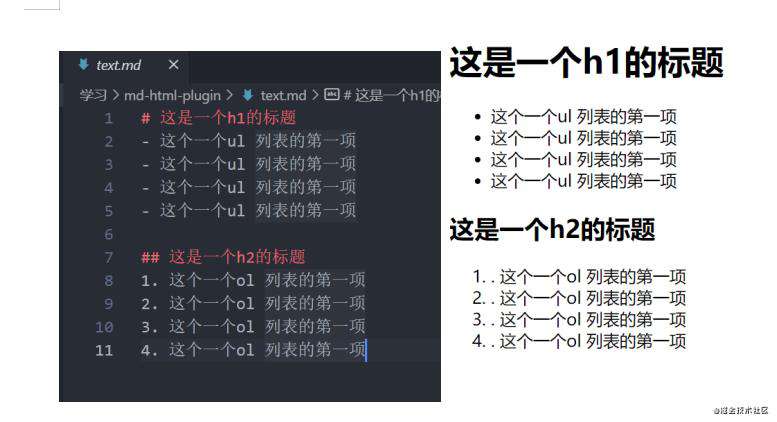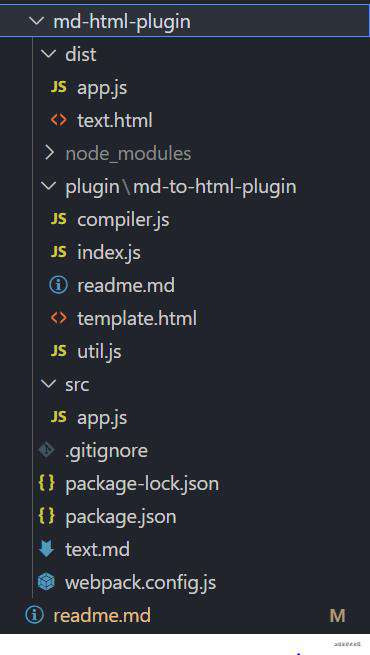前言
前段时间有在学习webpack的基础知识,但是无论是文档还是入门小视频,都没有直接在实践中学的好一点。
下面我会从我在这个完成Markdown转HTML的plugin插件中学到的一些知识点(相当于巩固自己之前的webpack入门吧),逐一理一理。(b站前端小野森森的视频,有兴趣可以看下) 包括但不限于:
- webpack的一些基础配置
- 一些正则表达式的书写
- 如何构建一颗DOM树
- ......
整个的代码在这-> md-to-html-plugin
实现的效果时这样的:左边的markdowm渲染成右边的html

暂时先不去想具体怎么实现Markdown转HTML,首先来看看我们要怎么开始,先放出目录:

- 首先你得用webpack搭个项目吧(入门的webpack有了用武之地)
- 创建一个plugin文件夹,里面是我们的这个插件的灵魂
- 既然是md转html 那我们的有个 md文档吧, 我md文档要先转成像
<h1>**</h1>类似的包裹了内容的字符串, 再插入到template.html模板中 再输出一个html文件
1. 使用webpack搭建项目 (回顾篇)
- 创建一个md-to-html-plugin 的文件夹
使用如下命令
- npm init -y
- npm install webpack webpack-cli webpack-dev-server -D
在根目录下创建
- webpack.config.js
- src/app.js
- plugin/md-to-html-plugin/ index.js
- plugin/md-to-html-plugin/ compier.js
(md文档要先转成像<h1>**</h1>类似的包裹了内容的字符串)
- plugin/md-to-html-plugin/template.html
下面依次介绍一下:
2.webpack.config.js 配置
包含:
- 打包入口 entry
- 出口 output
- 模式 mode
- plugin MdToHtmlPlugin (我们自己写的)
const { resolve } = require('path')
const MdToHtmlPlugin = require('./plugin/md-to-html-plugin')
module.exports = {
mode: 'development',
entry: resolve(__dirname, 'src/app.js'),
output: {
path: resolve(__dirname, 'dist'),
filename:'app.js'
},
plugins: [
new MdToHtmlPlugin({
template: resolve(__dirname, 'text.md'),
filename: 'text.html'
}),
]
}
3. md-to-html-plugin/ index.js 有关plugin
3.1 插件的定义:
3.2 MdToHtmlPlugin基础结构
const { readFileSync } = require('fs') 1. 需要读取文件 md和模板
const { resolve } = require('path')
const INNER_MARK = '<!-- inner -->' 2. template.html 中用来承载转换后的html标签
const {compileHTML} = require('./compiler') 3. md-html的转换
class MdToHtmlPlugin { 4. 在webpack配置中我们使用的是new的方式创建 这边,我们设置一个class类,它接受两个参数,md文档的文件名,和输出的文件名
constructor({ template, filename }) {
5. 如果md文件找不到,直接保错
if (!template) {
throw new Error('template 找不到')
}
this.template = template
6. 设置输出文件名,如果有文件名就配置,如果没有,就设置成'md.html'
this.filename = filename ? filename : 'md.html'
}
7. apply()方法
apply(compiler) {
compiler.hooks.emit.tap('md-to-html-plugin', (compilation) => {
// 我把整个apply方法的内容放到下面去分析了
8. 在这个方法里面,我们会将md文档读取处理,生成一颗dom树,再放回template.html里面
})
}
}
module.exports = MdToHtmlPlugin
3.3 apply()方法
- compiler
- compiler.hooks.emit.tap
- emit: 生成资源到 output 目录之前
- 参数:
compilation
- compilation
apply(compiler) {
compiler.hooks.emit.tap('md-to-html-plugin', (compilation) => {
const _assets = compilation.assets;
const _mdContent = readFileSync(this.template, 'utf8');
const _templateHtml = readFileSync(resolve(__dirname, 'template.html'), 'utf8')
// 将md文档 分行转换成数组 _mdContentArray
const _mdContentArray = _mdContent.split('\n')
// 通过compileHTML方法将这个数组构建成dom树 _htmlStr
const _htmlStr = compileHTML(_mdContentArray)
// 将dom插入到template.html中
const _finalHTML = _templateHtml.replace(INNER_MARK,_htmlStr)
_assets[this.filename] = {
source() {
return _finalHTML
},
size() {
return _finalHTML.length
}
}
})
}
官网:
- 一个具名 JavaScript 函数。
MdToHtmlPlugin - 在它的原型上定义
apply方法。apply(compiler) - 指定一个触及到 webpack 本身的 事件钩子。
compiler.hooks.emit.tap - 操作 webpack 内部的实例特定数据。
- 在实现功能后调用 webpack 提供的 callback
4. md-to-html 字符串转换
4.1 使用js对象创建树
4.1.1 创建一颗怎样的树:
{
'h1-1626856207419': { type: 'single', tags: [ '<h1>这是一个h1的标题\r</h1>' ] },
'ul-1626856207993': {
type: 'wrap',
tags: [
'<li>这个一个ul 列表的第一项\r</li>',
'<li>这个一个ul 列表的第一项\r</li>',
'<li>这个一个ul 列表的第一项\r</li>',
'<li>这个一个ul 列表的第一项\r</li>'
]
},
'h2-1626856207560': { type: 'single', tag: [ '<h2>这是一个h2的标题\r</h2>' ] },
'ol-1626856207336': {
type: 'wrap',
tags: [
'<li>. 这个一个ol 列表的第一项\r</li>',
'<li>. 这个一个ol 列表的第一项\r</li>',
'<li>. 这个一个ol 列表的第一项\r</li>',
'<li>. 这个一个ol 列表的第一项</li>'
]
}
}
4.1.2 详细步骤:
首先之前在index.js里面有个compileHTML(_mdContentArray),我们将一行行形成的数组作为参数传递给了 compileHTML,希望compileHTML这个函数可以先将md数组,再转换成一个dom树,再将这棵树插入到模板里面。
- md数组转换成dom树
里面分成三种 分别是
# ##标题类 我们需要转换成h1 h2-无序列表 我们需要转换成 ul li1. 2.有序列表 我们需要转换成 ol li
当然每个标签里面还有我们需要的内容。 input = matched.input
- 使用正则将这集中情况区分
const reg_mark = /^(.+?)\s/
// 匹配 # 开头
const reg_sharp = /^\#/
// 匹配 无序列表 -
const reg_crossbar = /^\-/
// 匹配 有序列表 1. 2.
const reg_number = /^\d/
- 还有一个需要注意的
ul里面的li,和ol里面的li,他们都是一起放到ul或者是ol里面的,因此需要做判断上一次的开通标签和这次的是否是相同的
_lastMark === mark
4.1.3 具体代码:
function createTreel(_mdArr) {
let _htmlPool = {}
let _lastMark = '' // 用于判断,是不是像li标签一样,需要一起放到ol或者ul里面
let _key = 0
_mdArr.forEach(mdFragment => {
// console.log(mdFragment)
const matched = mdFragment.match(reg_mark);
if (matched) {
const mark = matched[1]
const input = matched.input
console.log(matched,'matched') // 我们可以看一下这里的matched 打印出的东西是什么
// md-to-html 三种操作 标题 无序列表 有序列表
}
});
return _htmlPool
}
下面是matched 打印出来的东西
const mark = matched[1] md匹配的 # ## - 1.等
const input = matched.input 内容
[ '# ', '#', index: 0, input: '# 这是一个h1的标题\r', groups: undefined ] matched
[ '- ', '-', index: 0, input: '- 这个一个ul 列表的第一项\r', groups: undefined ] matched
[ '- ', '-', index: 0, input: '- 这个一个ul 列表的第一项\r', groups: undefined ] matched
[ '- ', '-', index: 0, input: '- 这个一个ul 列表的第一项\r', groups: undefined ] matched
[ '- ', '-', index: 0, input: '- 这个一个ul 列表的第一项\r', groups: undefined ] matched
[ '## ', '##', index: 0, input: '## 这是一个h2的标题\r', groups: undefined ] matched
['1. ','1.',index: 0,input: '1. 这个一个ol 列表的第一项\r',groups: undefined] matched
['2. ','2.',index: 0,input: '2. 这个一个ol 列表的第一项\r',groups: undefined] matched
['3. ','3.',index: 0,input: '3. 这个一个ol 列表的第一项\r',groups: undefined] matched
[ '4. ', '4.', index: 0, input: '4. 这个一个ol 列表的第一项', groups: undefined ] matched
4.3 md-to-html字符串详细处理
4.3.1 key 唯一值处理
function randomNum() {
return new Date().getTime() + parseInt(Math.random() * 1000);
}
module.exports = {
randomNum
}
4.3.2 对标题的处理 h1 h2
- 首先匹配这个标题 h1.h2...
if (reg_sharp.test(mark)) { // 匹配#开头的
const tag = `h${mark.length}`; // 转换成h1 h2等
const tagContent = input.replace(reg_mark, '')
if (_lastMark === mark) {
// 如果前一次的标签和这次的标签是一样的,之前拼接
_htmlPool[`${tag}-${_key}`].tags = [..._htmlPool[`${tag}-${_key}`].tags,`<${tag}>${tagContent}</${tag}>`]
} else {
// 否则 创建一个新的标题标签
_lastMark = mark
_key = randomNum();
_htmlPool[`${tag}-${_key}`] = {
type: 'single', // 单个标识
tags: [`<${tag}>${tagContent}</${tag}>`]
}
}
}
4.3.3 对无序列表的处理
if (reg_crossbar.test(mark)) {
// console.log(matched)
const tagContent = input.replace(reg_mark, '');
const tag = 'li';
if (reg_crossbar.test(_lastMark)) {
_htmlPool[`ul-${_key}`].tags = [..._htmlPool[`ul-${_key}`].tags ,`<${tag}>${tagContent}</${tag}>`]
} else {
_lastMark = mark
_key = randomNum();
_htmlPool[`ul-${_key}`] = {
type: 'wrap',// 多个标识
tags: [`<${tag}>${tagContent}</${tag}>`]
}
}
}
4.3.4 对有序列表的处理
if (reg_number.test(mark)) {
const tagContent = input.replace(reg_number, '')
const tag = 'li'
if (reg_number.test(_lastMark)) {
_htmlPool[`ol-${_key}`].tags = [..._htmlPool[`ol-${_key}`].tags ,`<${tag}>${tagContent}</${tag}>`]
} else {
_lastMark = mark;
_key = randomNum();
_htmlPool[`ol-${_key}`] = {
type: 'wrap',
tags: [`<${tag}>${tagContent}</${tag}>`]
}
}
}
4.4 模板编译
function compileHTML(_mdContentArray) {
const _htmlPool = createTreel(_mdContentArray)
// sconsole.log(_htmlPool)
let _htmlStr = ''
let item
for (let k in _htmlPool) {
// console.log(k, _htmlPool[k])
item = _htmlPool[k]
if (item.type === 'single') {
// 单个标题标签
item.tags.forEach((tag) => {
_htmlStr += tag;
})
} else if (item.type === 'wrap') {
// 多个标签 列表
console.log(item.tags,'2')
let _list = `<${k.split('-')[0]}>`
item.tags.forEach((tag) => {
_list += tag;
})
_list += `</${k.split('-')[0]}>`
_htmlStr += _list
}
}
return _htmlStr
}
module.exports = {
compileHTML
}
5. 放入模板编译
再body里面有个注释<!-- inner --> 之后我们可以将处理好的html放到这里
<!DOCTYPE html>
<html lang="en">
<head>
<meta charset="UTF-8">
<meta http-equiv="X-UA-Compatible" content="IE=edge">
<meta name="viewport" content="width=device-width, initial-scale=1.0">
<title>Document</title>
</head>
<body>
<!-- inner -->
</body>
</html>
参考文档:
1.webpack compiler 钩子
2.视频
还有很多不会不懂的地方,继续学习中。。。

常见问题FAQ
- 免费下载或者VIP会员专享资源能否直接商用?
- 本站所有资源版权均属于原作者所有,这里所提供资源均只能用于参考学习用,请勿直接商用。若由于商用引起版权纠纷,一切责任均由使用者承担。更多说明请参考 VIP介绍。
- 提示下载完但解压或打开不了?
- 找不到素材资源介绍文章里的示例图片?
- 模板不会安装或需要功能定制以及二次开发?






发表评论
还没有评论,快来抢沙发吧!